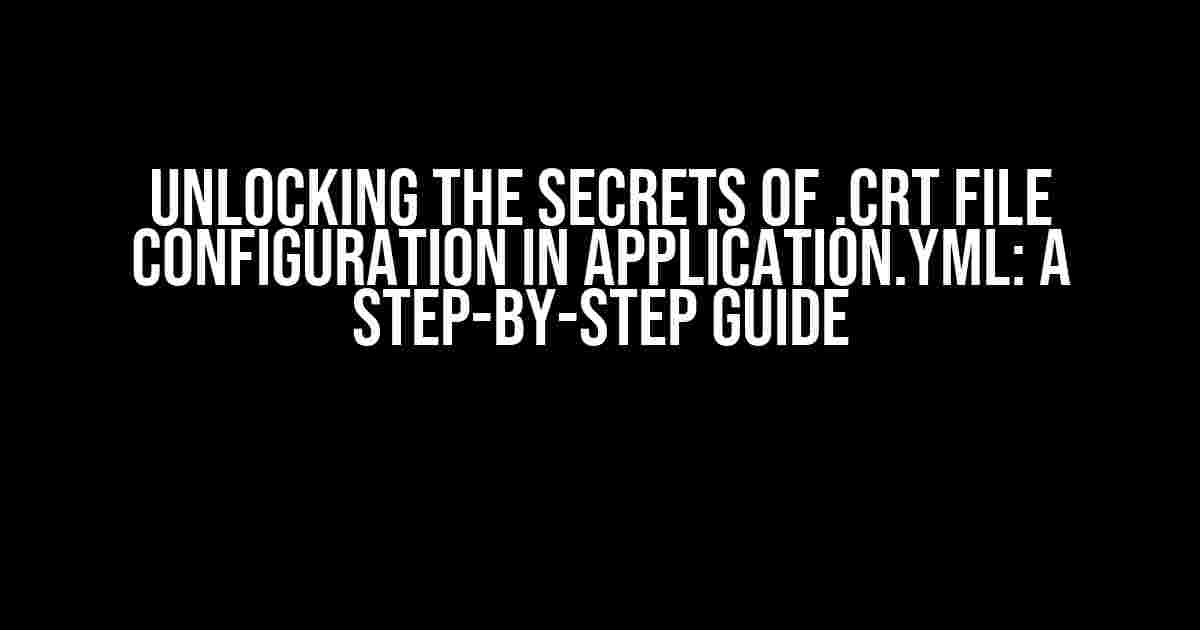Are you tired of scratching your head over how to configure your .crt file content in Application.yml? Look no further! In this comprehensive guide, we’ll demystify the process, providing clear and direct instructions to get you up and running in no time.
What is a .crt file, and why do I need it?
A .crt file, also known as a certificate file, is a critical component in securing your application’s communication over the internet. It contains the public key and identity information of your server, which is used to establish trust with clients (like web browsers) during SSL/TLS handshakes. Think of it as a digital ID card that verifies your server’s authenticity.
In the context of Application.yml, a .crt file is essential for configuring SSL/TLS encryption, ensuring the secure exchange of data between your application and users. Without proper configuration, your app may be vulnerable to man-in-the-middle attacks, data breaches, and other security risks.
Preparation is Key: Gathering Your Certificates
Before diving into the configuration process, make sure you have the following certificates ready:
- A private key file (typically with a .key extension)
- A certificate signing request (CSR) file (usually with a .csr extension)
- A signed certificate file (your .crt file)
- A certificate authority (CA) bundle file (optional, but recommended)
If you’re not familiar with generating these files, consult your Certificate Authority’s documentation or seek guidance from a qualified system administrator.
Configuring Your .crt File Content in Application.yml
Now that you have your certificates, it’s time to configure your .crt file content in Application.yml. Open your Application.yml file in a text editor, and let’s get started!
Step 1: Define the SSL/TLS Configuration
Add the following code block to your Application.yml file, replacing the placeholders with your actual certificate files:
server:
ssl:
enabled: true
key-store:
type: PEM
path: /path/to/your/private/key.key
key-store-password: your_private_key_password
trust-store:
type: PEM
path: /path/to/your/trust_store.crt
password: your_trust_store_password
cert-chain:
- /path/to/your/signed/certificate.crt
- /path/to/your/intermediate/certificate.crt
- /path/to/your/root/certificate.crt
In this example:
key-storedefines the path to your private key file and its password.trust-storespecifies the path to your trust store (optional) and its password.cert-chainlists the certificates in the correct order, from signed certificate to intermediate and root certificates.
Step 2: Configure the Certificate Chain
In the cert-chain section, you’ll need to specify the paths to each certificate in the chain. The order of the certificates is crucial:
- Signed certificate (your .crt file)
- Intermediate certificate (if applicable)
- Root certificate (if applicable)
Make sure to update the paths to match your actual file locations.
Step 3: Verify Your Configuration
Save your changes to Application.yml and restart your application. Use a tool like OpenSSL to verify the SSL/TLS configuration:
openssl s_client -connect yourdomain.com:443
This command will establish a connection to your server, displaying the SSL/TLS handshake details, including the certificates presented.
| Certificate | Path |
|---|---|
| Signed certificate | /path/to/your/signed/certificate.crt |
| Intermediate certificate | /path/to/your/intermediate/certificate.crt |
| Root certificate | /path/to/your/root/certificate.crt |
Verify that the certificates presented match the ones you configured in Application.yml.
Troubleshooting Common Issues
If you encounter issues during the configuration process, refer to the following troubleshooting tips:
- Check the certificate file paths and permissions.
- Verify the private key password and ensure it matches the one in the key-store section.
- Confirm the certificate chain order is correct.
- Test your SSL/TLS configuration using a tool like OpenSSL or SSL Labs.
Conclusion
Configuring your .crt file content in Application.yml is a crucial step in securing your application’s communication. By following this step-by-step guide, you’ve successfully configured your SSL/TLS certificates, ensuring a trusted connection between your application and users. Remember to regularly update and maintain your certificates to ensure the highest level of security.
Now, go forth and secure your application with confidence!
Frequently Asked Question
Are you struggling to configure your .crt file content in application.yml? Don’t worry, we’ve got you covered! Here are some frequently asked questions and answers to help you out.
Q: What is a .crt file, and why do I need to configure it in application.yml?
A: A .crt file is a certificate file that contains your SSL/TLS certificate, which is used to establish secure connections between your application and clients. Configuring it in application.yml allows your application to use the certificate to enable HTTPS and secure communication.
Q: What is the format of the .crt file content in application.yml?
A: The format of the .crt file content in application.yml typically includes the certificate, private key, and any intermediate certificates, separated by newline characters. For example: `server.ssl.certificate=—–BEGIN CERTIFICATE—–…—–END CERTIFICATE—–\nserver.ssl.key=—–BEGIN PRIVATE KEY—–…—–END PRIVATE KEY—–`.
Q: How do I specify the path to my .crt file in application.yml?
A: You can specify the path to your .crt file using the `server.ssl.certificate` property, followed by the file path. For example: `server.ssl.certificate=file:/path/to/your/certificate.crt`.
Q: Can I configure multiple .crt files in application.yml?
A: Yes, you can configure multiple .crt files in application.yml by using separate properties for each certificate. For example: `server.ssl.certificate1=…`, `server.ssl.certificate2=…`, and so on.
Q: What if I encounter issues with the .crt file configuration in application.yml?
A: If you encounter issues with the .crt file configuration, check the application.yml file for syntax errors, ensure that the file path is correct, and verify that the certificate and private key are in the correct format. You can also consult the official documentation or seek support from your application’s community or developers.
